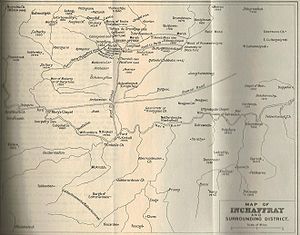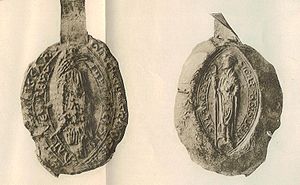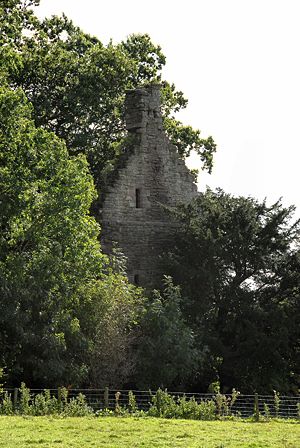
Inchaffray Abbey
Encyclopedia




Madderty
Madderty is a village in Strathearn, Perth and Kinross. It lies on the former railway line connecting Perth and Crieff. The Gask Ridge and its Roman road lie to the south and the remains of Inchaffray Abbey to the north....
, midway between Perth
Perth, Scotland
Perth is a town and former city and royal burgh in central Scotland. Located on the banks of the River Tay, it is the administrative centre of Perth and Kinross council area and the historic county town of Perthshire...
and Crieff
Crieff
Crieff is a market town in Perth and Kinross, Scotland. It lies on the A85 road between Perth and Crianlarich and also lies on the A822 between Greenloaning and Aberfeldy. The A822 joins onto the A823 which leads to Dunfermline....
in Strathearn
Strathearn
Strathearn or Strath Earn is the strath of the River Earn, in Scotland. It extends from Loch Earn in Perth and Kinross to the River Tay....
, Scotland
Scotland
Scotland is a country that is part of the United Kingdom. Occupying the northern third of the island of Great Britain, it shares a border with England to the south and is bounded by the North Sea to the east, the Atlantic Ocean to the north and west, and the North Channel and Irish Sea to the...
. The only trace now visible is an earth mound and some walls on the island where the abbey once stood.
History
Folk etymology has the name Inchaffray taken from the GaelicScottish Gaelic language
Scottish Gaelic is a Celtic language native to Scotland. A member of the Goidelic branch of the Celtic languages, Scottish Gaelic, like Modern Irish and Manx, developed out of Middle Irish, and thus descends ultimately from Primitive Irish....
innis abh reidh (island of the smooth water), but the earliest attested form of the name is the Latin
Latin
Latin is an Italic language originally spoken in Latium and Ancient Rome. It, along with most European languages, is a descendant of the ancient Proto-Indo-European language. Although it is considered a dead language, a number of scholars and members of the Christian clergy speak it fluently, and...
Insula missarum (island of the masses), mass in Gaelic being oifrend and Welsh offeren, thus island of the offerings. A charter of Jonathan, bishop of Dunblane
Bishop of Dunblane
The Bishop of Dunblane or Bishop of Strathearn was the ecclesiastical head of the Diocese of Dunblane/Strathearn, one of medieval Scotland's thirteen bishoprics. It was based at Dunblane Cathedral, now a parish church of the Church of Scotland. The bishopric itself certainly derives from an older...
, refers to the place "qui uocatur lingua Scottica Inche Affren" (="which is called in the Gaelic language Inche Affren") and comparative usage shows that Insula Missarum was taken as a translation, e.g. "Sancti Johannis evangeliste de Inchefrren" and "sancto Johanni apostolo de Insula Misserum".
A priory was created on an existing religious site by Gille Brigte, Earl of Strathearn
Gille Brigte, Earl of Strathearn
Gille Brigte of Strathearn is the third known Mormaer of Strathearn. He is one of the most famous of the Strathearn mormaers. He succeeded his father Ferchar in 1171. He is often known by the Francization of his name, Gilbert, or by various anglicizations, such as Gilbride, Gilbridge, etc...
and his first known wife Maud d'Aubigny in around 1200. Dedicated to their memory of their first-born son Gille Críst, to the Virgin Mary, and to John the Evangelist
John the Evangelist
Saint John the Evangelist is the conventional name for the author of the Gospel of John...
, the abbey was granted to the Augustinians
Augustinians
The term Augustinians, named after Saint Augustine of Hippo , applies to two separate and unrelated types of Catholic religious orders:...
of Scone Abbey
Scone Abbey
Scone Abbey was a house of Augustinian canons based at Scone, Perthshire , Scotland. Varying dates for the foundation have been given, but it was certainly founded between 1114 and 1122....
. The charter survives, and also names the churches of Saint Cathan
Saint Cathan
Saint Cathan, also known as Catan, Cattan, etc., was a 6th-century Irish monk revered as a saint in parts of western Scotland. He appears in the Aberdeen Breviary, Walter Bower's Scotichronicon, and the Acta Sanctorum, and a number of placenames in western Scotland are associated with him...
of Abruthven, Saint Ethernan of Madderty, Saint Patrick
Saint Patrick
Saint Patrick was a Romano-Briton and Christian missionary, who is the most generally recognized patron saint of Ireland or the Apostle of Ireland, although Brigid of Kildare and Colmcille are also formally patron saints....
of Strogeith, Saint Makkessog of Auchterarder
Auchterarder
Auchterarder is a small town located north of the Ochil Hills in Perth and Kinross, Scotland, and home to the famous Gleneagles Hotel. The 1.5 mile long High Street of Auchterarder gave the town its popular name of "Lang Toon"....
, and Saint Bean of Kinkell. The details of the earlier establishments are not certain, but a church dedicated to John the Evangelist is attested in about 1190. Gille Brigte's new priory became an abbey in about 1220.
Inchaffray was patronised both by the Mormaers of Strathearn and by the Scottish kings. In 1275 a tithe
Tithe
A tithe is a one-tenth part of something, paid as a contribution to a religious organization or compulsory tax to government. Today, tithes are normally voluntary and paid in cash, cheques, or stocks, whereas historically tithes were required and paid in kind, such as agricultural products...
of real income was assessed on all religious houses to fund a crusade, at which time Inchaffray had an income of 246 pounds per annum, fourth among Augustinian houses, exceeded only by St Andrews
St Andrews
St Andrews is a university town and former royal burgh on the east coast of Fife in Scotland. The town is named after Saint Andrew the Apostle.St Andrews has a population of 16,680, making this the fifth largest settlement in Fife....
, Scone and Holyrood
Holyrood
Holyrood is an anglicisation of the Scots haly ruid . It may refer to:*Holyrood , relics of the True Cross on which Jesus died-Scotland:* Holyrood, Edinburgh, an area of Edinburgh...
. In time the abbey's lands and dependent churches stretched across Scotland, as far away as Uist
Uist
Uist or The Uists are the central group of islands in the Outer Hebrides of Scotland.North Uist and South Uist are linked by causeways running via Benbecula and Grimsay, and the entire group is sometimes known as the Uists....
in the west and Balfron
Balfron
Balfron, is a village in the Stirling council area of Scotland. It is situated near Endrick Water on the A875 road, 18 miles west of Stirling and 16 miles north of Glasgow. Although a rural settlement, it lies within commuting distance of Glasgow, and serves as a dormitory town.-History:The name...
in the south.
Abbot Maurice of Inchaffray carried the relics of Saint Fillan
Fillan
Saint Fillan, Filan, Phillan, Fáelán or Faolan is the name of two Scottish saints, of Irish origin. The career of a historic individual lies behind at least one of these saints Saint Fillan, Filan, Phillan, Fáelán (Old Irish) or Faolan (modern Gaelic) is the name of (probably) two Scottish...
to bless the Scots army before the battle of Bannockburn
Battle of Bannockburn
The Battle of Bannockburn was a significant Scottish victory in the Wars of Scottish Independence...
in 1314. Abbot Laurence Oliphant, who came from a notable Strathearn family, was killed at Flodden in 1514.
By 1561 Inchaffrey's fortunes had declined, its income being assessed at 667 Pound Scots
Pound Scots
The pound Scots was the national unit of currency in the Kingdom of Scotland before the country entered into political and currency union with the Kingdom of England in 1707 . It was introduced by David I, in the 12th century, on the model of English and French money, divided into 20 shillings...
, third lowest of the Augustinian abbeys in Scotland included in the levy. With the Scottish Reformation
Scottish Reformation
The Scottish Reformation was Scotland's formal break with the Papacy in 1560, and the events surrounding this. It was part of the wider European Protestant Reformation; and in Scotland's case culminated ecclesiastically in the re-establishment of the church along Reformed lines, and politically in...
underway, Inchaffray had been turned into a secular lordship for a member of the Drummond family in 1556, and later passed to the Earls of Kinnoull
Earl of Kinnoull
Earl of Kinnoull is a title in the Peerage of Scotland. It was created in 1633 for George Hay, 1st Viscount of Dupplin. Other associated titles are: Viscount Dupplin , Lord Hay of Kinfauns and Baron Hay of Pedwardine . The former two are in the Peerage of Scotland, while the last is in the Peerage...
. Much which remained of the abbey was destroyed in 1816 when a road was driven across the site.
Today a single gable end wall stands in private property, although it is visible from the road.
External links
- Gazetteer for Scotland
- PSAS, volume 126: "Inchaffrey Abbey: Excavation and Research 1987" by Gordon Ewart et al., pp. 469–516.

